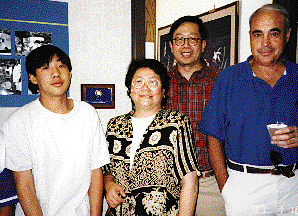GOLDSEA | ASIAMS.NET | ASIAN AMERICAN PERSONALITIES
DR DNA
PAGE 6 of 7
"Why don't you think about it and call me back tomorrow," Fong suggested. A few hours later Sharma called to accept the offer. During his year with Clontech he answered the phone, prepared solutions, put together a mailing list, among a wide variety of tasks. "He was pretty good but absent minded," Fong says, chuckling. "He was 27 and was living with a 45-year-old caucasian woman. This woman had two kids. Vic had an interesting style."
| "Our PhDs are quite independent." |
The third employee to be hired--Clontech's longest-lasting employee--is a Chinese American woman named Chai Yang who had been referred by the business next door. She began by packaging and shipping products and has since moved over into production. "She's actually very good, doing extremely well," Fong says.
She was followed by a biology graduate from UC Davis named Lyle Abraham who turned out to be a valuable jack-of-all trades.
"Lyle did everything, technical sales, computer, everything," Fong recalls affectionately. "He built a small lab for us too. He's a little undisciplined but he would do everything for you if you ask him. He left but he comes to see me from time to time. He's still a very good friend of mine."
Other longtime employees include Carol Lou who joined Clontech six years ago and is now vice president of operations, and scientific director Paul Siebert who joined ten years ago.
"He doesn't manage the PhDs," Fong says, evidencing a high degree of sensitivity to employee relations, "he works with them. Our PhDs are quite independent. We have five groups right now. Each is directed by a director who is a PhD. They're quite independent."
In 1984 Clontech earned no profits on its $50,000 in sales, mostly to universities and biotech companies. That year Fong took no salary and counted on Pam's solid earnings as an optometrist for living expenses.
In 1985 sales went up to $200,000 on which Clontech barely broke even.
The next year sales jumped to $1 million on the strength of sales of cDNA pools and DNA libraries which today represent about 10% of Clontech's sales now that more customers use Clontech's PCR product line--currently its most important--to amplify, or make copies of, DNA samples.
In 1987 slower sales and the pressures of financing growth created a cashflow crunch which forced Fong to solicit $200,000 in investments. He declines to elaborate, but most or all of these investors seem to have been bought out some time ago after earning a 400% return on their investments.
During the following 12 years Clontech has enjoyed steady growth at an average rate of over 35% a year. Its gross profits percentages are now on par with highly profitable software companies, but high levels of R&D spending keeps net profits in the 10-15% range.

At the dedication of the UC Berkeley Optometry Alumni Center donated by the Fong family
"The net usually depends on how much you want to spend for tomorrow," Fong says. "You look at some electronics company who do $200 million in sales, their profits could be less than mine." He cites a friend in the computer industry whose company was doing $300 million in sales and was earning less than Clontech which had less than a tenth the revenues. "I don't want to increase sales just to get the number up.
"Last year we grew 40%. We double every two, three years. We can probably do that until we are $100 million in sales, then we have to diversify our product line."
One avenue of future growth has been to sell pharmaceutical companies on the notion of paying Clontech to do some of their R&D instead of simply buying its research tools piecemeal.
"Suppose you have $10 million for this project. Why not let us have $2 million and do it for you. You can still save eight million dollars and I can do it better and faster. We have to convince them that we can do it better and faster."
"The question we asked was, Can we leverage our tools to address this potential? Instead of selling at $500 or $600 a pop we would like to sell at $2 million pop. Using the same technology that we're selling without inventing any new technology we actually got three projects from Hoffman-LaRoche for about $1.8 million."
Fong has created a team to approach other major pharmaceutical companies like Merck about outsourcing research.
Identifying new business opportunities, Fong says, is his primary mission as CEO. That requires him to devote a certain number of hours to reading pertinent industry literature, meeting with scientists working in promising new areas and giving talks to various professional and civic organizations.
"I travel not as frequently as most other company heads," he says. "It's better for [my employees] to do it because if Ken goes there, they might not learn as well as if they had done it on their own. As long as we agree on agenda and approach, I would rather they do it than me. PAGE 7
Page 1 |
2 |
3 |
4 |
5 |
6 |
7 |
CONTACT US
|
ADVERTISING INFO
© 1996-2013 Asian Media Group Inc
No part of the contents of this site may be reproduced without prior written permission.
